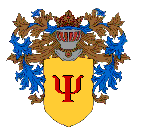
The Philosophies and Religions of the Roman Empire
Dr. C. George Boeree

The Philosophies and Religions of the Roman Empire
Dr. C. George Boeree

Rome was founded c. 500 bc. By 200 bc, it ruled most Italy, and in 150 bc, it conquered Carthage, the greatest power of the western Mediterranean at the time. By 150 bc, only three cities had over 100,000 people: Antioch, Alexandria, and Rome. By 44 bc, Rome would rule them all.
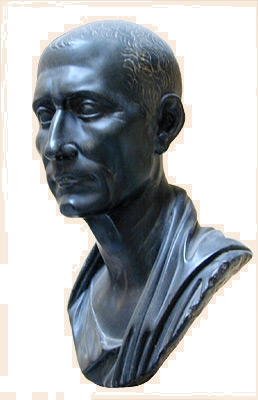 When Julius Caesar
was assassinated in 44 bc (pretty much as
Shakespeare described it!), that ended the vigorous Roman Republic. His
adopted heir, calling himself Augustus Caesar, became first
emperor. The Roman Empire
would reach its greatest extent in 116 ad under the Emperor Trajan.
When Julius Caesar
was assassinated in 44 bc (pretty much as
Shakespeare described it!), that ended the vigorous Roman Republic. His
adopted heir, calling himself Augustus Caesar, became first
emperor. The Roman Empire
would reach its greatest extent in 116 ad under the Emperor Trajan.
As you can imagine, the best minds of Rome were absorbed into politics, war, and economics. Few had the luxury of abstract philosophizing. Besides which, the Greeks had done that already, and look how far it got them: Quite a number of Greek philosophers wound up as Roman slaves, tutoring the youth of Roman aristocracy!
In this atmosphere, we find a powerful renewed interest, among the rich and poor alike, in religion. The old religion of Rome was given lip service, to be sure. But most saw the gods as little more than stories to scare naughty children (except when the adults themselves got frightened!). They were looking for comfort in uncertain times, and they found philosophy too dry. Many different cults -- of the Great Mother, of Dionysus, of Isis from Egypt, Mithra from Persia, Baal from Syria, Yahweh from Palestine -- became popular. Eventually, the Judaic sect we now call Christianity would prevail.
(To find out more about the early Jews and their beliefs, click
here!)
Why talk about religions and religious
philosophies in a book on the history of psychology? There are
actually a number of reasons. First, religion, philosophy,
science, and psychology all come from the same human roots: We
have a strong desire, even need, to understand the nature of the
universe, our place in that universe, and the meaning of our
lives. Religion included answers to these issues that have been
psychologically satisfying as well as socially and politically
powerful. Philosophy began separating from religion in the Greek
and Roman times, and yet the great majority of people stuck with
religion for their answers. In the renaissance and enlightenment,
science began to separate from both religion and philosophy, and still
the great majority remained loyal to religious dogma. And
throughout much of history, religions have often taken a strongly
anti-philosophical and anti-scientific position. Psychology
inherits some of these issues, even into the modern era. It is
valuable to any student of the history of philosophy, science, and
psychology to understand the roots of religious belief and the power of
those beliefs.
Neo-Platonism
Roman Philosophy was rarely more than a pale reflection of the
Greek, with
occasional flares of literary brilliance, but with few innovative
ideas.
On the one hand, there was the continuation of a sensible, if somewhat
plodding,
stoic philosophy, bolstered to some extent by the tendency to
eclecticism
(e.g. Cicero). On the other hand, there was the growing movement
towards
a somewhat mystical philosophy, an outgrowth of Stoicism usually
referred to as
Neo-Platonism.
Its best known proponent was Plotinus.
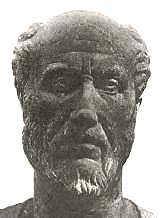
Plotinus (204-269) was born in Lycopolis in Egypt. He studied with
Ammonius Saccus, a philosopher and dock worker and teacher of the
church father Origen, in Alexandria. Plotinus left for Rome in
244, where he would teach until his death. He would have
considerable influence on the Emperor Julian "the Apostate," who tried
unsuccessfully to return the Roman Empire to a philosophical version of
Paganism, against the tide of Christianity.
On a military campaign to Persia, he encountered a variety of Persian and Indian ideas that he blended with Plato's philosophy:
God is the supreme being, the absolute unity, and is indescribable. Any words (even the ones I just used) imply some limitation. God is best referred to as “the One,” eternal and infinite. Creation, Plotinus believed, is a continuous outflow from the One, with each “spasm” of creation a little less perfect than the one before.
The first outflow is called Nous (Divine Intelligence or Divine Mind, also referred to as Logos), and is second only to the One -- it contemplates the One, but is itself no longer unitary. It is Nous that contains the Forms or Ideas that the earlier Greeks talked about. Then comes Psyche (the World Soul), projected from Nous into time. This Psyche is fragmented into all the individual souls of the universe. Finally, from Psyche emanates the world of space, matter, and the senses.
Spirituality involves moving from the senses to contemplation of one’s own soul, the World Soul, and Divine Intelligence -- an upward flow towards the One. Ultimately, we require direct ecstatic communion with the One to be liberated. This made neo-Platonism quite compatable with the Christianity of ascetic monks and the church fathers, and with all the forms of mysticism that would flourish in the following 1800 years!
Another proponent of Neo-Platonism worth
mentioning is Hypatia of
Alexandria
(370-415). A woman of great intellect, she became associated with
an enemy of the Christian Bishop Cyril. He apparently ordered his
monks to "take care" of her. They stripped her naked, dragged her
from her home, beat her, cut her with tiles, and finally burned her
battered body. The renaissance artist Raphael thought enough of
her to include her in
his masterpiece, The School of Athens.
Mithraism
One of the most popular religions of the Roman Empire, especially among Roman soldiers, was Mithraism. Its origins are Persian, and involves their ancient hierarchy of gods, as restructured by Zarathustra (c. 628-c. 551 bc) in the holy books called the Avestas.
The universe was seen as involved in an eternal fight between light and darkness, personified by Ahura-Mazda (good) vs. Ahriman (evil). This idea probably influenced Jews while they were in Babylon, which is when they adopted HaShatan -- Satan -- as the evil one!
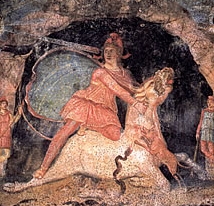 Within the Persian pantheon, Mithra
was “the judger of
souls” and
“the protector,” and was considered the representative of Ahura-Mazda
on
earth.
Within the Persian pantheon, Mithra
was “the judger of
souls” and
“the protector,” and was considered the representative of Ahura-Mazda
on
earth.
Mithra, legend says, was incarnated into human form (as prophesized by Zarathustra) in 272 bc. He was born of a virgin, who was called the Mother of God. Mithra's birthday was celebrated December 25 and he was called “the light of the world.” After teaching for 36 years, he ascended into heaven in 208 bc.
There were many similarities with Christianity: Mithraists believed in heaven and hell, judgement and resurrection. They had baptism and communion of bread and wine. They believed in service to God and others.
In the Roman Empire, Mithra became associated with the sun, and was referred to as the Sol Invictus, or unconquerable sun. The first day of the week -- Sunday -- was devoted to prayer to him. Mithraism became the official religion of Rome for some 300 years. The early Christian church later adopted Sunday as their holy day, and December 25 as the birthday of Jesus.
Mithra became the patron of soldiers. Soldiers in the Roman legions believed they should fight for the good, the light. They believed in self-discipline and chastity and brotherhood. Note that the custom of shaking hands comes from the Mithraic greeting of Roman soldiers.
It was operated like a secret society, with rites of passage in the form of physical challenges. Like in the gnostic sects (described below), there were seven grades, each protected by a planet.
Since Mithraism was restricted to men, the wives of the soldiers often belonged to clubs of Great Mother (Cybele) worshippers. One of the women’s rituals involved baptism in blood by having an animal- preferably a bull - slaughtered over the initiate in a pit below. This combined with the myth of Mithra killing the first living creature, a bull, and forming the world from the bull's body, and was adopted by the Mithraists as well.
When Constantine converted to Christianity, he outlawed Mithraism. But a few Zoroastrians still exist today in India, and the Mithraic holidays were celebrated in Iran until the Ayatollah came into power. And, of course, Mithraism survives more subtly in various European -- even Christian -- traditions.
Christianity
Jesus was born, it is thought, about 6 bc. His name is a Latinization of the Hebrew name Yeshua, which we know as Joshua. Legend has it that he was born in the small town of Bethlehem, to a virgin named Mary, the fiancée of a carpenter, Joseph. He grew up in Nazareth, part of a large Jewish family. He was apparently very intelligent and learned, for example, to read without formal education.
As a young man, he became very religious, and joined a group of ascetic Jews led by a charismatic leader named John the Baptist. When John was beheaded by local authorities for “rabble-rousing,” many began looking to Jesus for leadership.
He had 12 disciples from various towns and walks of life, and literally hundreds of other followers, men, women, and children. They wandered the area, in part to spread their beliefs, in part to stay ahead of unfriendly authorities.
At first, Jesus’s message was a serious, even fundamentalist, Judaism. He promoted such basic ethics as loving one’s neighbor and returning hatred with kindness. He particularly emphasized the difference between the formal religion of the priests and Jewish ruling class and the less precise, but more genuine, zeal of the simple people. Supporting the message was his apparent ability to heal the sick.
The Jews of his time felt oppressed by their Roman overlords, and many believed that their God would intervene on behalf of his people by sending a messiah -- a charismatic leader who would drive out the Romans and establish a new Jewish state.
Many of Jesus’s followers, of course, believed that he was the messiah. At some point in his career, he began to believe this, too. Unfortunately, the Jewish authorities, answerable to the Romans, were concerned with his popularity, and had him arrested in Jerusalem.
He was condemned to death and crucified. His followers were clearly disappointed that the promised Jewish state was not delivered. But rumor of his coming back to life, and his appearance as a vision to several of his followers, reignited their faith. Many believed that he would return -- soon! -- to lead them.
As time went by, of course, it was clear that he wouldn’t be coming back in their lifetimes. The less messianic, more religious aspects of his teaching began to be emphasized, and his notion of the kingdom of God as within us, or at least as our heavenly reward, replaced the hoped-for Jewish state.
For better or worse, Judea was actually quite metropolitan -- heavily “Hellenized” if not so “Romanized.” The same currents of thought in other parts of the empire were felt here as well. So the story of Jesus, as recorded in the gospels of Mark, Matthew, and Luke, began to be attached to ideas that were more properly neo-Platonist, gnostic, or even Mithraist!
The gospel of John, for example, is very different from the others, and refers to Jesus as the word, or Logos -- a common Greek idea. Revelations, also attributed to John, but very different in style and content, has all the complex imagery of gnostic and Mithraist end-of-the-world stories, popular among the Jews at this time. It includes the idea of an eventual resurrection of the body -- a concept that Jesus of the gospels did not promote, and which most Christians today do not believe in.
 But it was Paul (c. 10 -
c. 64 ad), a Romanized Jew, who
would be
most responsible for re-creating Jesus, whom he had never met, and
never refers
to by name. He is also responsible for divorcing this newly
formed
religion from its Jewish roots. It was Paul who introduced the
idea
that Jesus was the son of God and that only by faith in him could we
hope
to be “saved” from our inherent sinfulness.
But it was Paul (c. 10 -
c. 64 ad), a Romanized Jew, who
would be
most responsible for re-creating Jesus, whom he had never met, and
never refers
to by name. He is also responsible for divorcing this newly
formed
religion from its Jewish roots. It was Paul who introduced the
idea
that Jesus was the son of God and that only by faith in him could we
hope
to be “saved” from our inherent sinfulness.
For nearly a century, the early Christians were split into two hostile camps: One group followed Peter, one of Jesus’s original disciples. They were predominantly Jews and continued many Jewish traditions, as Jesus himself had done. The other group followed Paul, who was far more open to non-Jewish converts and waived much of Jewish law for those not born into it. The battle between these groups was, of course, won by Paul. Some critics suggest that Christianity ought to be called “Paulism!”
Both Peter and Paul were executed in Rome about 64 ad. Paul was beheaded. Peter was crucified upside-down (at his request, so as to avoid comparison with Jesus).
The Patrists, or church fathers, were the first Christian philosophers. In the eastern part of the empire, there was Origen of Alexandra (185-254); in the west, there was Tertullian of Carthage (165-220). Tertullian is best remembered for saying that he believed (in the death and resurrection of Jesus Christ) precisely because it was absurd. Origen, on the other hand, had much more of the Greek in him, and pointed out that much of the Bible should be understood metaphorically, not literally. Keep in mind, though, that Origen cut off his own genitals because he took Matthew XIX, 12 literally!
The idea of the trinity, not found in the Bible itself, preoccupied
the
Patrists after Theophilius of Antioch introduced the concept in 180
ad.
Tertullian felt that the trinity referred to God, his word (Logos), and
his
wisdom (Sophia).
Origen was more precise, and said that it refers to the One (the
father),
intelligence (Logos, here meaning the son), and soul (Psyche, the holy
spirit),
following the Neo-Platonic scheme.
Because the concept of the trinity is a difficult one, it was the root
of many different interpretations which did not coincide with the
official explanation. These alternative interpretations were
labelled heresies, of course, and their authors excommunicated
and books burned. (Click
here for a
list of heresies!)
Origen also did not believe in hell: Like the Neo-Platonists, he thought that all souls will eventually return to the One. In fact, it is believed that Origen and the great neo-Platonist Plotinus had the same teacher -- a dock worker/philosopher by the name of Ammonius Saccus.
The Patrists' philosophies were for the most part the same: All truth comes from God, through the mystical experience they called grace (intuition, interior sense, light of faith). This clearly puts the church fathers in the same league as the neo-Platonists, and contrasts Christian philosophy with that of the ancient Greeks: To take truth on faith would be a very odd idea indeed to the likes of Socrates, Plato, Democritus, and Aristotle!
Christianity had certain strengths, with strong psychological (rather than philosophical) messages of protection, hope, and forgiveness. But its greatest strength was its egalitarianism: It was first and foremost a religion of the poor, and the empire had plenty of poor! Despite incredible persecution, it kept on growing.
Then, on the eve of battle on October 27, 312, a few miles north of Rome, Emperor Constantine had a vision of a flaming cross. He won the battle, adopted Christianity, and made it a legal religion with the Edict of Milan. In 391, all other religions were outlawed. But even then, Christianity still had competition.
Gnosticism
Gnosticism refers to a variety of religio-philosophical traditions going back to the times of the Egyptians and the Babylonians. All forms of Gnosticism involved the idea that the world is made up of matter and mind or spirit, with matter considered negative or even evil, and mind or spirit positive. Gnostics believe that we can progress towards an ultimate or pure form of spirit (God) by attaining secret knowledge -- “the way” as announced by a savior sent by God.
The details of the various gnostic sects depended on the mythological metaphors used -- Egyptian, Babylonian, Greek, Jewish, Christian... Gnosticism overall was heavily influenced by Persian religions (Zoroastrianism, Mithraism) and by Platonic philosophy.
There was a strong dependence on astrology (which they inherited from the Babylonians). Especially significant are the seven planets, which represent the seven spheres the soul must pass through to reach God. Magical incantations and formulas, often of Semitic origins, were also important.
When Christianity hit the stage, gnosticism adapted to it quickly, and began to promote itself as a higher, truer form of Christianity. The theology looked like this:
At first, there was just God (a kind of absolute). Then there
were
emanations from God called his sons or aions. The
youngest of
these aions was Sophia, wisdom and the first female
“son.” Sophia
had a flaw, which was pride, which then infected the rest of the
universe.
We need to undo this flaw (original sin) but we cannot do it on our
own. We
need a savior aion, who could release Sophia from the bonds of
error
and restore her to her status as an emanation of God.
Worship among the gnostics included baptism, confirmation, and the eucharist. In fact, it is likely that several of the non-canonical gospels were written by Christian gnostics, and some say that John was a gnostic.
Gnosticism was strongly refuted by the early Christian Church in the 100’s and 200’s, as well as by the neo-Platonists, like Plotinus, who saw it as a corruption of Plato’s thought. In fact, of course, the reason for the animosity was more a matter of how similar gnosticism was to Christianity and neo-Platonism!
Manicheanism
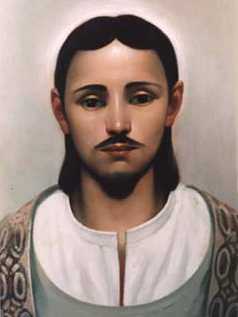 Manicheanism was founded by Mani,
born 215 ad in
Persia. At
12, he was visited by an angel, who told him to be pure for 12 more
years,
at which time he would be rewarded by becoming a prophet. He would
eventually
consider himself the seal (i.e. the last) of the prophets, a title
Mohammed
would later claim for himself.
Manicheanism was founded by Mani,
born 215 ad in
Persia. At
12, he was visited by an angel, who told him to be pure for 12 more
years,
at which time he would be rewarded by becoming a prophet. He would
eventually
consider himself the seal (i.e. the last) of the prophets, a title
Mohammed
would later claim for himself.
Forced to leave Persia, he wandered the east, preaching a gnostic version of Mithraism, with elements of Judaism, Christianity, and Buddhism. He considered himself an apostle of Jesus. When he returned to Persia, he was imprisoned and crucified.
In Manicheanism, Ormuzd (a corrupion of the name Ahura Mazda) is the good god, the god of light, creator of souls. There is also a god of evil and darkness -- sometimes referred to as Jehovah! -- who created the material world, even trapping Ormuzd’s souls in bodies. Another tradition has Ormuzd placing fragments of light -- reason -- in the evil one’s mannequins.
So there is light trapped inside of darkness! Mani believed that salvation comes through knowledge, self-denial, vegetarianism, fasting, and chastity. The elect are those who follow the rules most stringently. Their ultimate reward is a release of the light from its prison.
His followers were severely persecuted, by Persians and Romans alike. Still, the religion spread to Asia Minor, India, China, the Middle East, even Spain. It lasted in Europe until the 10th century ad and influenced later Christian heresies such as the Bogomils and the Cathars.
St. Augustine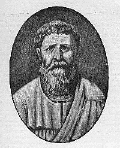
St. Aurelius Augustine of Hippo (354-430) was a Manichean
for 10 years before converted to Christianity in 386 ad. He would
go on to become the best
known Christian
philosopher prior to the Middle ages.
He is best known to us for the first truly psychological, introspective account of his search for truth, in his Confessions. A hint of the intimate detail of his account can be gotten from one of his best known quotes: He prayed to God to "give me chastity and continence, but not yet!"
His philosophy is a loose adaptation of Plato to the requirements of Christianity. In order to reconcile the idea that God is good with the evil that obviously exists in the world, he turned to the concept of free will and our personal responsibility for sin. And he emphasized intentions over actions when it comes to assigning moral responsibility
There are, of course, problems with his arguments: If God is omniscient and omnipotent, he knows what we will do and in fact made us this way, so isn’t he still responsible for evil? Besides which, despite the admittedly great evil we human beings do to each other, aren’t there also natural disasters and diseases that could be considered evil, yet have nothing to do with our free will? These arguments would trouble philosophers even into the twentieth century. (See Dostoevsky’s The Brothers Karamazov for examples!)
Augustine became bishop of Hippo Regius (west of Carthage) in 395. He died in 430, during the siege of Hippo by the Vandals, a Germanic tribe that conquered North Africa (which was the “breadbasket” of Italy in those times!). You could say he lived through the fall of the Roman Empire.
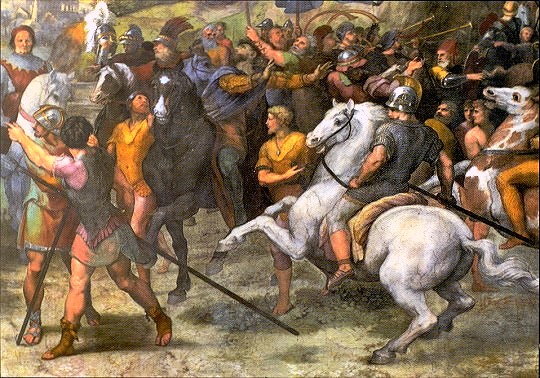
Islam
So, as the Roman Empire faded into the sunset, the opportunity for other civilizations to make a mark arose. I doubt that anyone at the time would have guessed that the major contender would come from the relatively desolate western coast of Arabia. Arabia could only marginally sustain its population agriculturally. But, positioned nicely between the wealthy empires to its north and the untapped resources of Africa to its south -- and later the ocean roots to India and beyond -- it managed to provide its people with the option of lucrative trade.
Mohammed was born 569 ad in Mecca, a merchant town near the Red Sea. His mother died when he was six, so he was raised, first by his grandfather, later by his uncle. He was probably illiterate, but that was the reality for most Arabs of the time.
At 26, he married a wealthy widow 14 years his senior, who would be his only wife until she died 26 years later. He would have ten more wives -- but no living son. He and his first wife had a daughter, Fatima, who would become a significant character in Islamic history. She married Mohammed’s adopted son, Ali.
As he got older, he became increasingly religious, and sought to learn about Judaism and Christianity. He began to meditate alone in the desert and local caves.
In 610 ad, Mohammed fell asleep in a cave, when tradition has it that the angel Gabriel appeared to him and told him he would be the messenger of God (Allah*). He would have this experience repeatedly throughout the rest of his ife. Each time, the angel would provide him with a lesson (sura) which he was to commit to memory. These were eventually recorded, and after his death collected into the Islamic holy book, the Quran (or Koran).
He preached to the people of Mecca, but was met with considerable opposition from pagan leaders. When the threat of violence became clear, he left Mecca for the town of Medina, to which he had been invited, with some 200 of his followers. Here, he was much more successful, and eventually he took over secular authority of the the town.
Relations with the pagan families of Mecca continued to deteriorate, and relations with the Jews of Medina, at first promising, deteriorated as well. An alliance between the Meccan families and the Medina Jews fought Mohammed’s followers over the course of several years.
In 630, Mohammed took Mecca. Within two more years, all of Arabia was under his control, and Islam was a force to be reckoned with. Mohammed died June 7, 632.
Mohammed’s basic message was simple enough: We must accept Allah as the one and only God, and accept that Mohammed was his prophet. Say words to this effect three times, and you are a Moslem.
Islam means surrender, meaning that we are saved only by faith. Allah, being all-knowing, knows in advance who will and who will not be saved. This idea (which we will see again among the Protestants in Europe) tends to encourage bravery in battle, but it also tends to lead a culture into pessimistic acceptance of the status quo. But that would not happen to Islam for many hundreds of years!
The Quran says that some day (only Allah knows when), the dead will rise and be reunited with their souls. They will be judged. Some will be cast into one of the seven levels of hell. Some will be admitted into paradise -- described in very physical, even hedonistic, terms. Much of this scenario came from the Jews, who in turn got it from the Persians.
Islam is very rule-oriented, blending the religious with the secular. Church and State are one. In the Quran, there are rules for marriage, commerce, politics, war, hygiene -- very similar to the Jewish laws, which Mohammed imitated. Among those rules, Moslems are not to eat pork or dog meat and may not have sex during a woman’s period, just like the Jews. Mohammed added a rule against alcohol. The society Mohammed envisioned is approximated by such authoritarian states as Saudi Arabia and Iran today.
Marriage was encouraged, and celibacy considered sinful. Polygamy was permitted, within limits. Women, as in Judaism and Christianity, were clearly secondary to men, but were not to be considered property. They were equal to men in most legal and financial dealings, and divorce, while easy, was strongly discouraged. Likewise, although slavery was not condemned, many rules were designed to humanize the institution.
Mohammed and the Moslems were generally accepting of Jews and Christians (“people of the book”), but intolerant of pagans. War and capital punishment were clearly condoned and practiced by the prophet: “And one who attacks you, attack him in like manner” (ii, 194).
The Arabic culture and language, and the religion of Islam, soon
would dominate much of the world, from Spain and Morocco to Egypt and
Palestine to Persia and beyond. For a while, it would present a
progressive, tolerant
face, and Moslem philosophy would rival that of the ancient Greeks.
(For more information about Islam, especially its Sunni and Shiite
branches, click here!)
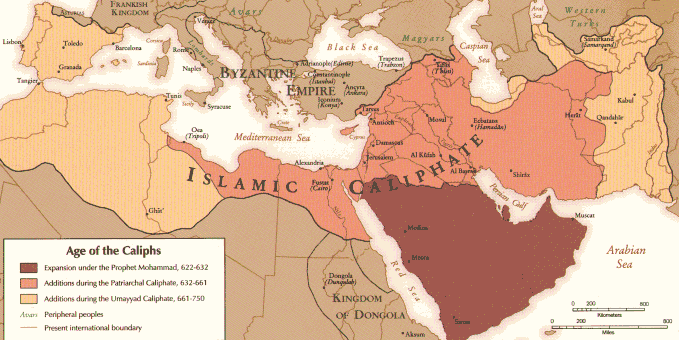
* Allah is the Arabic word meaning "the God." It comes from
the same root as the Hebrew Elohim, and ultimately comes from the
Cananite word El, which referred to the father of all the gods.
© Copyright 2001, C. George Boeree